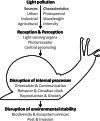Slowly seeing the light: an integrative review on ecological light pollution as a potential threat for mollusks
- PMID: 33341922
- PMCID: PMC7838132
- DOI: 10.1007/s11356-020-11824-7
Slowly seeing the light: an integrative review on ecological light pollution as a potential threat for mollusks
Abstract
Seasonal changes in the natural light condition play a pivotal role in the regulation of many biological processes in organisms. Disruption of this natural condition via the growing loss of darkness as a result of anthropogenic light pollution has been linked to species-wide shifts in behavioral and physiological traits. This review starts with a brief overview of the definition of light pollution and the most recent insights into the perception of light. We then go on to review the evidence for some adverse effects of ecological light pollution on different groups of animals and will focus on mollusks. Taken together, the available evidence suggests a critical role for light pollution as a recent, growing threat to the regulation of various biological processes in these animals, with the potential to disrupt ecosystem stability. The latter indicates that ecological light pollution is an environmental threat that needs to be taken seriously and requires further research attention.
Keywords: Artificial light; Biorhythm; Mollusca; Reproduction; Slugs; Snails; Zeitgeber.
Conflict of interest statement
The authors declare that they have no conflict of interest.
Figures

Similar articles
-
The Minderoo-Monaco Commission on Plastics and Human Health.Ann Glob Health. 2023 Mar 21;89(1):23. doi: 10.5334/aogh.4056. eCollection 2023. Ann Glob Health. 2023. PMID: 36969097 Free PMC article. Review.
-
How ecological communities respond to artificial light at night.J Exp Zool A Ecol Integr Physiol. 2018 Oct;329(8-9):394-400. doi: 10.1002/jez.2157. Epub 2018 Apr 14. J Exp Zool A Ecol Integr Physiol. 2018. PMID: 29656458 Free PMC article. Review.
-
Introduction to the Symposium: Effects of Light Pollution Across Diverse Natural Systems.Integr Comp Biol. 2021 Oct 4;61(3):1089-1097. doi: 10.1093/icb/icab157. Integr Comp Biol. 2021. PMID: 34251459
-
Artificial light at night: a global disruptor of the night-time environment.Philos Trans R Soc Lond B Biol Sci. 2023 Dec 18;378(1892):20220352. doi: 10.1098/rstb.2022.0352. Epub 2023 Oct 30. Philos Trans R Soc Lond B Biol Sci. 2023. PMID: 37899010 Free PMC article. Review.
-
The loss of ecosystem-services emerging from artificial light at night.Chronobiol Int. 2019 Feb;36(2):296-298. doi: 10.1080/07420528.2018.1534122. Epub 2018 Oct 19. Chronobiol Int. 2019. PMID: 30339482
Cited by
-
Slugs hide in the dark: Artificial light at night alters fitness and activity of dominant herbivores with consequences for ecosystem functioning.iScience. 2025 May 27;28(6):112770. doi: 10.1016/j.isci.2025.112770. eCollection 2025 Jun 20. iScience. 2025. PMID: 40546966 Free PMC article.
-
I can't hear you: effects of noise on auditory processing in mixed-species flocks.J Exp Biol. 2025 May 15;228(10):jeb250033. doi: 10.1242/jeb.250033. Epub 2025 May 22. J Exp Biol. 2025. PMID: 40223503 Free PMC article.
-
Central Nervous System Associated With Light Perception and Physiological Responses of Birds.Front Physiol. 2021 Oct 21;12:723454. doi: 10.3389/fphys.2021.723454. eCollection 2021. Front Physiol. 2021. PMID: 34744764 Free PMC article.
-
Clocks at a snail pace: biological rhythms in terrestrial gastropods.PeerJ. 2024 Oct 29;12:e18318. doi: 10.7717/peerj.18318. eCollection 2024. PeerJ. 2024. PMID: 39494278 Free PMC article. Review.
-
Effects of Artificial Light at Night on Fitness-Related Traits of Sea Urchin (Heliocidaris crassispina).Animals (Basel). 2023 Sep 27;13(19):3035. doi: 10.3390/ani13193035. Animals (Basel). 2023. PMID: 37835640 Free PMC article.
References
-
- Abt KF, Schultz G. Auswirkungen der Lichtemissionen einer Gro\s sgewächshausanlage auf den nächtlichen Vogelzug. Corax. 1995;16:17–29.
-
- Albertano P, Barsanti L, Passarelli V, Gualtieri P. A complex photoreceptive structure in the cyanobacterium Leptolyngbya sp. Micron. 2000;31:27–34. - PubMed
-
- Arendt D. The evolution of cell types in animals: emerging principles from molecular studies. Nat Rev Genet. 2008;9:868–882. - PubMed
-
- Arendt D, Tessmar K, de Campos-Baptista M-IM, Dorresteijn A, Wittbrodt J. Development of pigment-cup eyes in the polychaete Platynereis dumerilii and evolutionary conservation of larval eyes in Bilateria. Development. 2002;129:1143–1154. - PubMed
-
- Arendt D, Tessmar-Raible K, Snyman H, Dorresteijn AW, Wittbrodt J. Ciliary photoreceptors with a vertebrate-type opsin in an invertebrate brain. Science. 2004;306:869–871. - PubMed
Publication types
MeSH terms
Grants and funding
LinkOut - more resources
Full Text Sources

